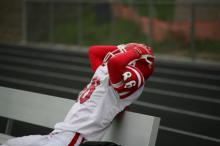
Head injuries in football, as in other contact and collision sports, cannot be completely eliminated, but there ARE steps that can be taken to minimize risk.
The Smartest Team focuses on what MomsTEAM.com Founder and Publisher Brooke de Lench calls The Six Pillars™ of concussion risk management:
Pillar One: Comprehensive concussion education
A comprehensive concussion risk management program begins with education.
When MomsTEAM, working with one of the country's pre-eminent concussion experts, Dr. Robert Cantu, launched its comprehensive concussion center in 2001 - becoming, in Dr. Cantu's words, the "pioneers" in youth sports concussion education - the subject was years away from gaining the attention of the national media.
Today, virtually every expert in the field puts concussion education at the top of the list of ways in which football - and all contact and collision sports - can be made safer.
All stakeholders in football - athletes, referees, administrators, parents, coaches, and health care providers - should be educated about:
1. ways to reduce the risk of concussion and brain/neck/spine injury (Pillar Two)
2. early identification of concussion, its clinical features (signs and symptoms), and assessment techniques (Pillar Three)
3. conservative treatment and management (physical and cognitive rest) and return to learn (Pillar Four)
4. principles of cautious return to play (Pillar Five); and
5. factors suggesting that retirement from football and other contact and collision sports is advisable (Pillar Six)
Pillar Two: Protection (Minimizing Risk)
Experts believe that, while there is no way to make football completely concussion-risk free, there are a number of ways the risk of brain injury from playing contact and collision sports can be minimized:
1. Requiring pre-participation physical evaluations of all players on a yearly basis;
2. Equipping players with properly fitted and maintained helmets;
3. Training players to tackle and block without using their helmets;
4. Enforcing existing rules against helmet-to-helmet contact;
5. Enacting new rules to further reduce helmet-to-helmet contact;
6. Encouraging players to maintain peak physical condition and strengthen neck muscles; and
7. Working to reduce total brain trauma through sensible. evidence-based limits on full-contact practices.
All seven present challenges, suggesting that adopting an "all-of-the-above" approach is likely the best way to reduce the risk to youth and high school athletes from brain injury, both in the short- and long-term.
Pillar Three: Early Identification/Immediate Removal from Play
To minimize the risk of delayed recovery and long-term injury (or, in rare instances, catastrophic injury or death from diffuse cerebral swelling, a/k/a "second impact syndrome"), it is critical that football players suspected of having sustained a concussion be removed from play as soon as possible, a step now required by law, at least at the high school level, in nearly all states.
Because of the well-documented and persistent unwillingness of athletes to report concussion symptoms (especially those they consider minor, e.g. 'bell-ringers' or 'dings'), and because the vast majority of sport-related concussions occur without loss of consciousness or other obvious neurological signs and may not be the result of a specific concussive blow, identifying a concussion, especially early, continues to be a challenge.
To increase the chances of early identification, a multi-pronged approach utilizing every "tool" in the concussion toolbox is recommended, including the "Six E's":
1. Employing a certified athletic trainer to be on the sideline at every game and practice;
2. Encouraging honest self-reporting by athletes of concussion symptoms and use of a "buddy system" in which players look for - and report - signs of concussion in designated teammates;
3. Equipping players with impact sensors to alert sideline personnel to blows which may cause concussion;
5. Evaluating players for suspected concussion on the sideline utilizing a battery of assessment tools; and
6. Ensuring that any player suspected of concussion not be allowed to return to game or practice play but referred for more formal evaluation and assessment by a qualified medical professional whenever concussion is suspected.
Pillar Four: Conservative Treatment (Physical/Cognitive Rest)
Along with teachers, coaches, school nurses, school psychologists, neuropsychologists, and administrators, parents play a crucial role in a child's treatment and recovery from diagnosed concussion. No matter how 'mild' a concussion may seem, concussion is a traumatic brain injury (TBI), and need to be treated seriously.
Immediately after a concussion, engaging in even the most basic physical or mental tasks can make symptoms worse and slow recovery. In the first few days after concussion parents therefore need to make sure their child get lots of rest and limits physical exertion and activities of daily living.
Because a concussion impacts the brain's cognitive functions (e.g. those that involve thinking, concentrating, learning, memory, and reasoning), limiting an athlete's scholastic and other cognitive activities, at least initially, is believed to give the brain time to heal and is thought to speed recovery.
The optimal amount and timing of physical and cognitive rest, however, is not yet known. Experts therefore recommend taking a common sense approach, keeping a concussed student-athlete home from school for a few days, and then easing back into school gradually before returning to a full school day (what is now increasingly dubbed "return to learn") and social activities. The key is to reintroduce physical and mental activities in a way which does not make symptoms worse, and to discontinue any activity if it provokes symptoms or makes them worse.
In the event concussion symptoms/cognitive impairment persist (e.g. post-concussion syndrome), management by a multi-disciplinary team of concussion specialists, more formal academic accommodations (e.g. "IEP" or "504 plan") and consideration of alternative therapies, may need to be considered.
Pillar Five: Cautious Return to Play
The return to play (RTP) protocol after a child or teen suffers a sport concussion should only begin after a student-athlete (1) reports being symptom free; (2) has returned to a full academic workload without accommodations; (3) is performing at or near their pre-injury baseline on all post-concussion tests; and (4) has been cleared by their doctor, based on his or her clinical judgment and consideration of all relevant factors, to begin the following, exercise-limited, return to play protocol:
1. No activity (symptom-limited physical and cognitive rest)(Pillar Four).
2. Light aerobic exercise
3. Sport-specific exercise
4. Non-contact training drills
5. Full-contact practice
6. Return to play.
Generally, each step takes 24 hours, so that concussed high school athletes whose symptoms clear within 24 hours (about 25% of the total) will take approximately 1 week to complete the full rehabilitation protocol, if they continue to be asymptomatic at rest and with exercise. While an estimated 80 to 90% of concussions heal spontaneously in the first 7 to 10 days, a more conservative RTP approach (longer rest period and/or extended period of non-contact exercise) is recommended for younger athletes.
Pillar Six: Retirement
Medicine has not yet figured out how many concussions is too many. There is no magic number. The number that leads to permanent deficits in memory, concentration, and other cognitive processes, and/or that increases the risk of dementia and other problems later in life, is likely to be different for each athlete.
Among the factors that may prompt a recommendation to an athlete to consider retiring from contact or collision sports (either not resume playing that season or not begin play the next season), are:
1. Number of concussions;
2. Concussions occurring with less force;
3. Slower recovery;
4. More pronounced cognitive losses; and
5. The role football plays in the athlete's life and his realistic prospects for college and pro career.
The decision to retire should be made jointly, after long discussion among and between the athlete, the athlete's family, other people important to the athlete (e.g. coach) and the health care team involved in the athlete's care, and should ideally take place over a series of visits lasting weeks to months.



